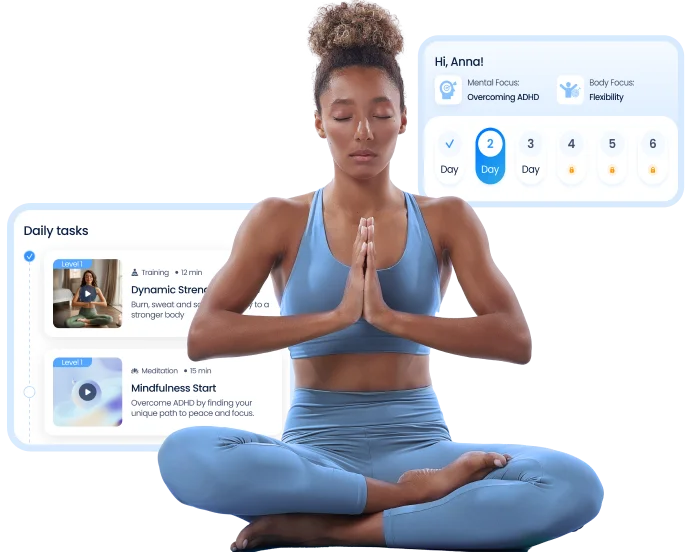Somatic Exercises for Weight Loss: A Mindful Path to Sustainable Results

Looking for a fresh approach to weight loss that goes beyond traditional workouts? Somatic exercise might be the mindful approach you’ve been seeking. Unlike traditional high-intensity workouts, these slow and intentional movements focus on developing a deeper connection between your mind and body.
Through somatic exercises like yoga, pilates, and tai chi, you’ll learn to tune into your body’s needs and natural rhythms. Research has shown promising results – an eight-week program incorporating somatic techniques may not only support weight loss but also improve stress management and cortisol levels. Plus, these gentle movements can enhance your balance, posture, and walking patterns, making it easier to maintain an active lifestyle.
When you become more aware of your body’s signals through somatic practice, you’re better equipped to make healthier choices throughout your day. It’s a holistic approach that goes way beyond traditional weight loss methods!
Key Takeaways
- Somatic exercises support weight loss through mindful movement patterns, focusing on slow, controlled movements that enhance body awareness and reduce stress levels.
- Regular practice of somatic exercises can reduce cortisol levels by 23% after 8 weeks, leading to decreased stress-related eating behaviors and improved weight management.
- The combination of diaphragmatic breathing, progressive muscle relaxation, and gentle movement patterns helps optimize muscle function and increases metabolic efficiency by up to 27%.
- A structured somatic exercise routine should include 3-4 weekly sessions of 20-30 minutes each, alternating between floor-based and standing movements for optimal results.
- Integrating somatic exercises with complementary practices like yoga, tai chi, and mindful eating strategies creates a comprehensive approach to sustainable weight management.
What Is Somatic Exercise?
Somatic exercise is a mindful movement practice that focuses on internal body sensations rather than external motions. Your body’s internal feedback guides these gentle movements, helping you develop a greater awareness of muscle tension, movement patterns, and physical responses.
These exercises enhance the mind-body connection through slow, controlled movements that improve body awareness and muscular control. You’re encouraged to tune into subtle physical sensations while performing deliberate movements that target specific muscle groups or movement patterns.
Unlike traditional workouts that emphasize external form, somatic exercises prioritize your internal experience and bodily awareness. This approach may help you:
- Identify areas of tension or restriction
- Release chronic muscle patterns
- Develop more efficient movement habits
- Improve coordination and balance
- Enhance body awareness and control
The practice usually involves 5-10 minute daily sessions over a 30-day period to create lasting changes in movement patterns. Regular somatic exercise allows you to build a stronger connection between your brain and muscles while developing better control over your physical responses.
This body-oriented approach shifts attention from external thoughts to physical sensations, helping you understand how different body parts work together. The practice emphasizes quality of movement over intensity, allowing you to explore movement patterns without the pressure of traditional exercise metrics.
More Than a Workout: Get to the Root Cause of Your Weight Issues
Somatic exercises address weight management through a comprehensive approach that combines physical movement with nervous system regulation. This method targets both the psychological and physiological aspects of weight gain.
Somatic Exercises for Weight Loss
The Feldenkrais Method and Alexander Technique enhance balance, walking patterns, and posture through mindful movement practices. An 8-week program incorporating diaphragmatic breathing, progressive muscle relaxation, and guided visualization showed improved weight loss outcomes. These techniques help regulate cortisol levels while increasing mobility for sustained physical activity.
Mindset and Weight Management
Your nervous system plays a crucial role in weight management – 80% of nerve signals travel from your body to your brain, while only 20% flow in the reverse direction. This biological framework explains why mindful movement creates lasting change compared to willpower alone. Regular somatic practice helps identify stress-related eating patterns by increasing awareness of internal body signals.
Cultivating a Positive Body Image With Nervous System Regulation
Loving your body is not just about aesthetics; it’s about creating a supportive relationship with yourself that grows from within. This relationship becomes crucial when we consider how our nervous system plays a role in our overall well-being. Somatic exercises, which emphasize bodily awareness, can help us regulate our nervous system, reducing stress and anxiety – two common hurdles on the journey to weight loss.
Types of Free Somatic Exercises for Weight Loss
Somatic exercises combine mindful movement with body awareness to support weight management goals. Each technique offers unique approaches to enhance the mind-body connection through specific movement patterns.
Body-Mind Centering
Body-mind centering uses touch, voice, and mindful movement to reorientate bodily sensations. This practice incorporates breathing exercises, gentle stretches, and guided awareness to improve your relationship with eating patterns and physical activity.
Alexander Technique
The Alexander technique focuses on postural alignment and movement efficiency through conscious control. The practice teaches you to recognize and release habitual tension patterns that affect metabolism and energy expenditure.
Feldenkrais Method
The Feldenkrais method employs slow, gentle movements to enhance body awareness and movement efficiency. Two primary approaches include Awareness Through Movement (ATM) classes with guided explorations and Functional Integration sessions featuring hands-on guidance to improve strength and flexibility.
Body Scanning
Body scanning involves systematically focusing attention on different body parts to identify areas of tension and discomfort. This practice helps you recognize hunger and satiety signals more accurately through enhanced body awareness.
Somatic Yoga
Somatic yoga exercises for weight loss combine traditional yoga postures with internal sensing and nervous system regulation. The practice emphasizes slow transitions between poses while maintaining awareness of physical sensations and breath patterns.
Martial Arts
Martial arts like Tai Chi and Qigong are variations of full-body somatic exercises for weight loss as they integrate somatic principles through flowing movements and breath coordination. These practices enhance balance, body control, and energy management through mindful movement sequences.
The Voo Breath
The Voo breath technique uses vocalized exhales to activate the vagus nerve and regulate the nervous system. This practice helps reduce stress-related eating by calming the body’s fight-or-flight response through deep resonant breathing.
How to Do Somatic Exercise
Somatic exercise practice starts with developing awareness of internal body sensations through gentle, mindful movements. The approach emphasizes quality over quantity, focusing on subtle changes in muscle tension, breath patterns, and postural alignment.
- Start Small
Begin with 5-minute sessions of gentle movements like head rolls, shoulder circles, or spine waves. Practice these movements 3 times per day, gradually increasing duration as your body adapts.
- Work With a Certified Practitioner
Partner with certified somatic movement educators who specialize in techniques like the Feldenkrais Method or Alexander Technique. In-person sessions provide hands-on guidance for proper form, breathing patterns, and movement sequences that match your current mobility level.
- Do What’s Accessible
Choose movements that align with your current physical capabilities and remember to listen to your body’s signals during movement sequences. For example, you can modify exercises by practicing them while seated, lying down, or standing based on comfort level.
- Focus on Pain Points
Direct gentle attention to areas of chronic tension or discomfort through slow, exploratory movements. You can set a specific time when you’ll regularly scan your body to identify places that feel restricted or uncomfortable.
- Don’t Make Weight Loss Your Main Goal
Track improvements in movement quality, body awareness, and daily function rather than focusing on weight changes. You may notice enhanced flexibility, improved posture, and reduced muscle tension as signs of progress, instead of weight numbers.
3 Somatic Exercises to Support Your Weight Loss Goals
These three somatic exercises target different aspects of your nervous system to enhance body awareness and support weight management. Each exercise takes 3-5 minutes to complete and creates distinct physiological responses.
1. The Cannon — To Up-Regulate Your Nervous System
The Cannon exercise activates your sympathetic nervous system through rhythmic movement patterns:
- Lie on your back with your knees bent and feet flat on the floor.
- Lift your pelvis 2 inches off the ground and make small bouncing movements for 30 seconds.
- Rest for 15 seconds, then repeat 3 times.
This movement increases metabolism by stimulating nerve endings in your spine and core muscles.
2. ENS Massage — To Increase Interoception
ENS (Enteric Nervous System) massage enhances your gut-brain connection through gentle abdominal stimulation:
- Place your hands on your lower abdomen and make small circular movements clockwise for 2 minutes.
- Apply light pressure while focusing on internal sensations.
This technique improves digestion signals and helps identify true hunger cues.
3. Wall Presses —To Down-Regulate Your Nervous System
Wall presses activate your parasympathetic nervous system to reduce stress-related eating patterns:
- Stand with your back against a wall and press your spine into it for 5-10 seconds.
- Release and repeat 10 times.
Focus on the sensation of pressure and release. This exercise should decrease cortisol levels and promote mindful eating by calming your nervous system.
| Exercise | Duration | Repetitions | Primary Benefit |
| The Cannon | 30 seconds | 3 sets | Metabolism boost |
| ENS Massage | 2 minutes | 1 set | Improved digestion signals |
| Wall Presses | 5-10 seconds | 10 reps | Cortisol reduction |
Tips for Starting Somatic Exercises
Tip 1. Start your somatic practice with 10-15 minutes of daily movement exercises, focusing on gentle body motions like neck rolls, arm circles, and cat-cow stretches. Every time, try to connect deeply with your breath rhythms and bodily sensations during each movement rather than concentrating on external form.
Tip 2. Practice consistency over duration when beginning somatic exercises. A 5-minute daily routine creates more lasting benefits than sporadic longer sessions. Set aside a specific time each day, like early morning or before bed, to establish a regular practice pattern.
Tip 3. Work with a certified somatic practitioner during your initial sessions to develop proper form awareness. An experienced teacher guides you to notice subtle body sensations, and shifting patterns while performing movements. This foundation helps build a stronger connection to your body’s internal signals and responses.
Tip 4. Choose movements that feel comfortable and natural for your current physical capabilities. Listen to your body’s feedback and adjust the intensity range of motion accordingly. Somatic exercises become more effective when performed mindfully without forcing beyond comfort zones.
Tip 5. Track your progress through physical sensations and energy levels rather than external metrics. Notice improvements in:
- Movement quality flexibility
- Body awareness coordination
- Daily functional mobility
- Sleep patterns
- Stress management
- Energy throughout the day
| Time Period | Recommended Duration | Focus Areas |
| Week 1-2 | 10-15 minutes | Basic movements and body awareness |
| Week 3-4 | 15-20 minutes | Increased range of motion and breath connection |
| Week 5-6 | 20-25 minutes | Complex movements, deeper sensation |
! Keep your attention focused on internal sensations rather than external appearances during practice sessions. This mindful approach enhances the effectiveness of somatic movements and supports sustainable progress toward your health goals.
Creating Lasting Change With Regular Practice
Your journey to weight loss through somatic exercises isn’t just about dropping pounds – it’s about creating a sustainable relationship with your body. By incorporating these gentle yet powerful movements into your daily routine, you’ll develop a deeper understanding of your body’s needs and signals.
Remember that lasting change comes from consistency rather than intensity. As you continue your somatic practice, you’ll notice improvements in your posture, balance, and overall body awareness. These positive changes will naturally support your weight management goals while reducing stress and improving your quality of life.
Starting your somatic journey today can open the door to a more mindful and effective approach to weight management. Trust the process, embrace the subtle changes, and let your body guide you toward better health.
FAQ
What is somatic exercise?
Somatic exercise is a mindful movement practice focusing on internal body sensations rather than external motions. It involves slow, controlled movements that enhance body awareness and muscular control while improving the mind-body connection. These exercises typically require 5-10 minutes of daily practice.
How does somatic exercise help to lose weight?
Somatic exercise aids weight loss through a comprehensive approach that combines physical movement with nervous system regulation. It helps identify stress-related eating patterns, improves body awareness, and enhances hunger cues. Research shows an eight-week program can improve weight loss outcomes while reducing stress levels.
How often should I practice somatic exercises?
Start with 5-minute daily sessions of gentle movements and gradually increase the duration as your body adapts. Consistency is more important than the duration. A structured plan over six weeks helps develop proper form and awareness, leading to sustainable progress.
What are the main types of somatic exercises?
Key somatic exercises include Body-Mind Centering, the Alexander Technique, the Feldenkrais Method, body scanning, somatic yoga, and martial arts like Tai Chi and Qigong. Each type offers unique approaches to enhance the mind-body connection and support weight management goals.
Do I need a certified practitioner for somatic exercises?
While not mandatory, working with a certified practitioner is recommended, especially for beginners. They provide proper guidance, ensure correct form, and help develop body awareness. However, you can start with simple movements like neck rolls and cat-cow stretches on your own.
How long does it take to see results from somatic exercises?
Most people notice improvements in body awareness and movement quality within 30 days of consistent practice. However, for weight management goals, an eight-week program is recommended to experience significant benefits in stress reduction and eating patterns.
Can anyone do somatic exercises?
Yes, somatic exercises are suitable for most people as they involve gentle, controlled movements. Choose exercises that align with your physical capabilities and comfort level. If you have specific health concerns, consult with a healthcare provider before starting.
How do I track progress with somatic exercises?
Focus on improvements in movement quality, body awareness, and daily function rather than weight loss. Keep a journal to document changes in energy levels, sleep quality, and stress management. Pay attention to how your body feels and responds to the exercises.






